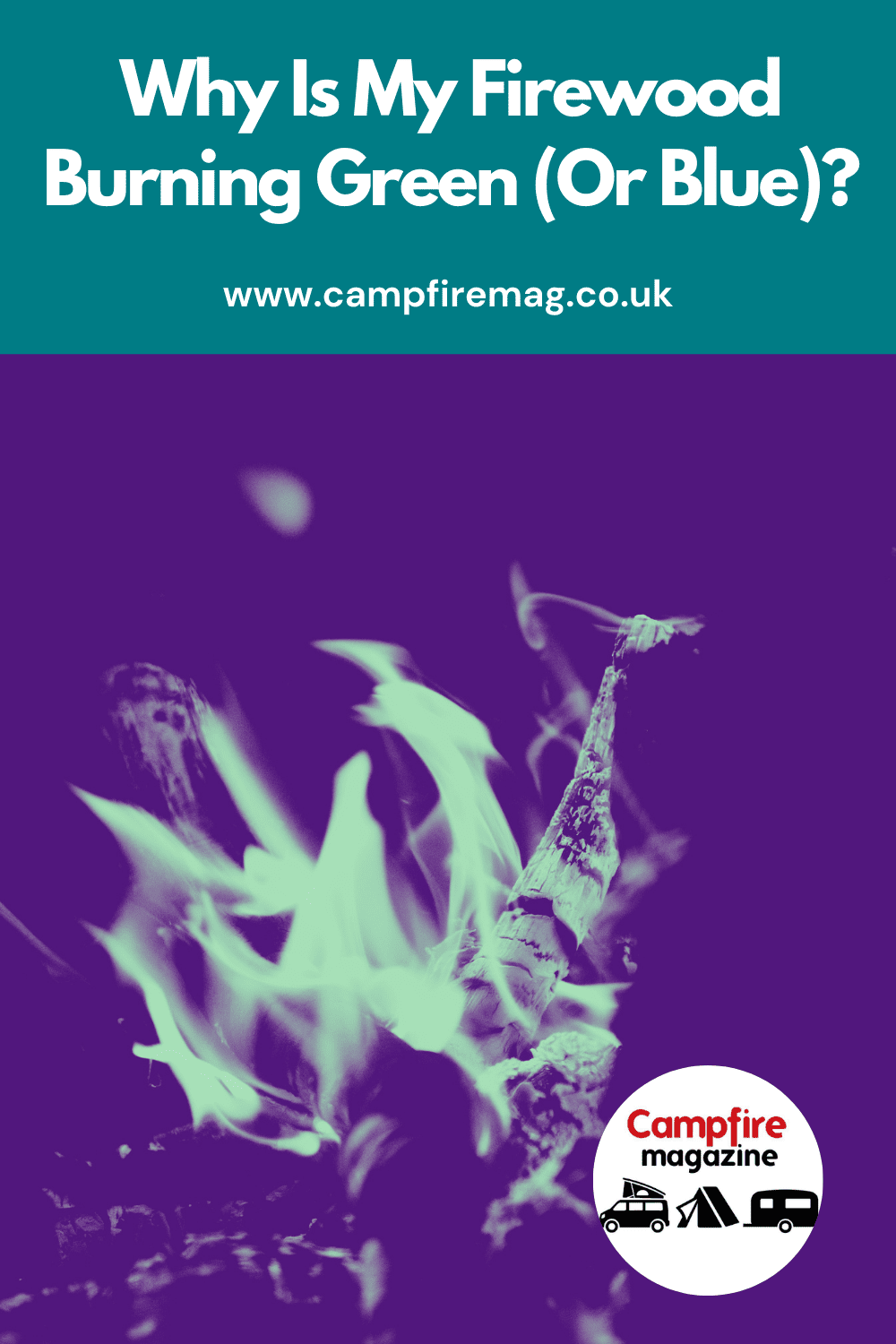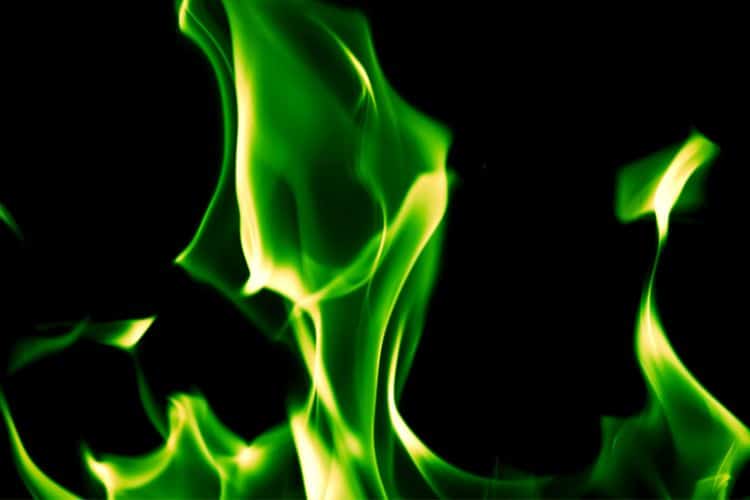Burning a fire is a great way to relax, keep warm and cook food both at home and when enjoying a camping trip. However, fire is hot and has the potential to spread, cause injuries and a whole host of other dangers. Understanding why a flame has a certain appearance can help you more safely use your fire.

Sometimes, flames might appear to have an unusual colour. There are some that are perfectly ok whereas others could indicate a problem. So, what do the different colours mean and why is the fire burning green or blue?
When a flame is green, this tells you that there might be some sort of chemical in the wood. A blue flame usually means that the fire is burning at a higher temperature, usually around 2300 degrees or more.
It’s never worth risking anything when working with fire so use this guide to determine whether your fire is safe and why the flames are a certain colour. We’ll also cover the best type of wood to use for a fire to make sure you’re extra safe!
Why Is My Fire Green?
Sometimes, you may notice that your flame burns green. This can come as a surprise as it’s not something that many people will have seen before.
There are a number of reasons that this could be the case but you’ll need to figure this out in order to determine whether it’s a problem or not. A lot of the time, a green flame tells you that there are serious issues. However, it could also simply be because of the type of wood you’re using.
Some types of wood can generate a green flame. Things like cedar may commonly do this but also any type of wood that has been treated with a pesticide could result in green flame.
Note that woods that have foxfire on them; a type of fungus that causes a luminescent glow, will also cause a green flame.
A lot of people assume that a colour change in the flame always equates to a change in temperature. While this is often true of a blue flame, the same cannot be said for a green one. Green flames may indicate an external cause of the colour change.
For the most part, this is to do with something that’s burning as well as just the wood. This might happen if you have chosen wood from a scrap pile or if the wood contains pesticides. Chemicals like this contain a compound called borax which will ignite as a green flame.
Wood that contains copper might also have a green flame. If there are no other obvious chemicals within the wood then copper is more than likely the culprit.
Now, the big question is whether this green flame is a danger to you. Generally speaking, if you’re just burning the fire to keep warm, a green flame isn’t much of a threat. However, we wouldn’t suggest trying to cook anything on this fire as the chemicals causing the green flame could get into your food.
You aren’t going to want to toast your marshmallows over a fire that contains copper. If you do, then you risk ingesting the substance and ending up with copper toxicity which can cause a range of unpleasant symptoms.
While using the fire for heat or ambiance, you should be OK as long as the area is well ventilated. If you’re outdoors using a firepit, this won’t be an issue but if you are using an indoor wood burning stove, you’ll want to improve airflow or extinguish the fire and use a different wood.

Why Is My Fire Blue?
A blue flame is perhaps something we’re all a little more familiar with. However, it’s certainly not the colour you would expect a fire to be so when you see it, it can feel quite alarming. Most of us will have learned in school that a blue flame is usually an indication that the temperature of the flame is above average.
But this isn’t something that’s unusual. For example, if you light a match, you’ll typically see that the base of the flame is blue whereas the rest is orange. This is because, at the base, the fire is burning hotter.
Sometimes, you will have a fire where the whole flame is blue and that’s when you know that this is a very hot fire. This is caused because of excess carbon. Fires like this can burn anywhere between 2300 degrees and 3000 degrees.
But where has this carbon come from? Well, in a lot of cases, this will happen if you’re using scrap wood that has rusted metal in it; things like nails and screws, for example.
Of course, you may know for certain that there aren’t any components like this in the wood so you’ll then need to think about how it was treated before burning. If it was pressure treated then this means it will likely contain copper and this can cause the blue flame.
But, as with the green flame, there are some types of wood that naturally burn hotter and will create a blue flame that’s totally harmless. These are things like American elm and black locust. In this case, it’s nothing to worry about. But certainly be careful of that super hot flame and take fire safety extremely seriously.
Again, if you’re burning a fire with a blue flame for decorative purpose or for heat, it isn’t going to do any harm. In fact, you might say that it’s very efficient as the carbon is completely burning which means that no other matter has a chance to; and that’s a good thing.
But, if the fire is being used for an appliance then there might be a risk of carbon monoxide so it’s really important to have a meter to check this. Carbon monoxide poisoning can be deadly and you won’t necessarily even know it’s happening until it’s too late.
What Colour Should The Flame Be?
When you think about a fire, you’ll normally imagine a bright orange flame. And that’s no surprise since this is the most common colour for a fire. Of course, the fuel you are using and anything that is contained within it can alter the colour of the flame significantly.
No matter what type of fuel you use; paper, wood, coal, gas or anything else, these all contain carbon. How much of this that burns will determine the colour of the flame.
But it isn’t only this that affects the colour; the temperature of the fire will also change the colour of the flame. Since most fires burn anywhere between 1100 and 2200 degrees, this creates the orange flame that we’re all used to seeing.
What Is The Best Wood For A Fire?
For the most part, the colour of the flame won’t make too much of a difference. Although there are a few exceptions such as a high carbon monoxide output. But choosing the best wood for a fire is important as this will ensure safer, cleaner and more efficient burning.
Hardwoods are generally thought of as the best wood and something like oak is particularly effective. The reason for this is that oak has a very clean burn and doesn’t give off a lot of smoke. Moreover, it’ll burn for much longer which is great when you need a fire that’ll see you through the entire evening.
However, you will notice that hardwoods, such as ash, birch, hickory and dogwood, do take a little more to get going. Igniting them can be a challenge so it’s usually best to use some sort of softwood before adding the hardwood in order to get the fire going. But once the fire is established, you won’t need to do much work other than sitting back and enjoying the flames.
There are some types of softwood that work well for a fire as they tend to ignite a lot more easily. This includes things like spruce and fir. What’s more, woods like these have a much more pleasant aroma so can create a relaxing atmosphere around the fire. The problem is that softwoods require a lot more management when burning and they’ll go out much sooner. What’s left behind is very little in the way of charcoal so it can also be difficult to get the fire going again once it goes out. That’s why most people choose to use softwood only for kindling.
Regardless of the type of wood you are using, it must be seasoned. Seasoned simply means dried and the wood has been left to sit for a period of time to remove as much moisture as possible.
When you use freshly cut wood, there will be a good amount of sap which can make igniting it difficult, sometimes impossible.
You can buy seasoned wood from many places including online suppliers or it is possible to season your own in a wood store. But keep in mind that you’ll need to leave it for at least 12 months if you want it to properly dry out.
Conclusion
When you see anything other than an orange flame on your fire, it can be alarming. But there’s no need to panic. Green and blue flames are common when there are additional compounds, like copper or carbon, being burned in the fire.
In most cases, this is harmless but it’s probably best not to cook over these flames as there is a risk of the chemicals contaminating your food.

